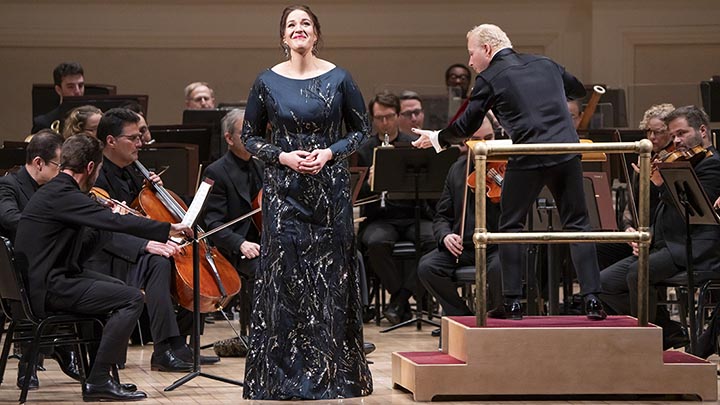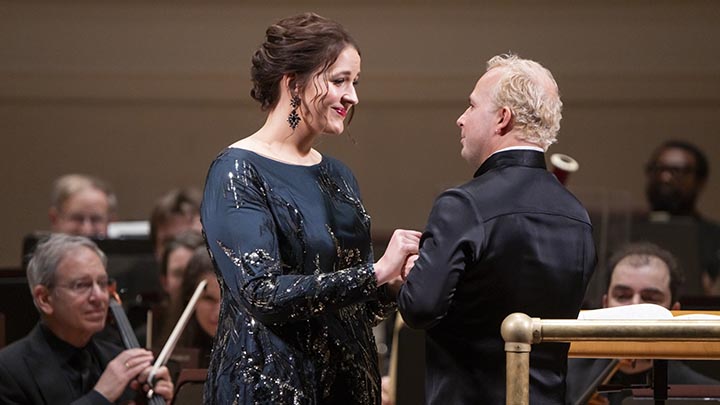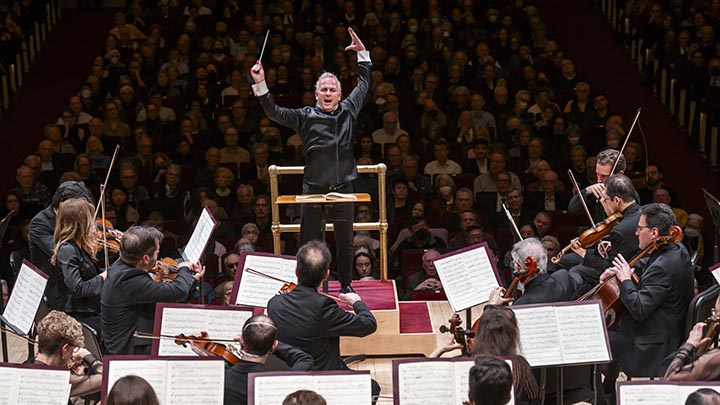
I asked myself this question as I watched The Met Orchestra make its return to Carnegie Hall last Thursday evening. I had attended the performance with my father, who in many ways nurtured my interest in music. He left after the first half to catch a train back to the suburbs, and I spent much of the intermission thinking back on the last time we had been in that hall together. And then the time before that. Then all the times prior. I wondered—really, how many hours?
As it turns out, the program was posing the same question. Traversing two centuries of German music, it began Baroque by way of the Second Viennese School with Anton Webern’s symphonic orchestration of Johann Sebastian Bach’s “Fuga (Ricercata) a 6 voci” from Musical Offering. It then settled into Romantic territory with Richard Wagner’s Wesendock Lieder and Gustav Mahler’s Symphony No. 5. All three pieces engaged in acts of looking inwards and back. Webern retreats from the chaos of his times into the structural coherence and tonal purity of Bach. Mahler, staring down the end of the Austro-German symphonic tradition and the emergence of the Modern, opens his symphony with an obvert nod to Beethoven’s own Fifth Symphony before launching into a densely layered exploration of counterpoint, evolving its expressive possibilities beyond anything present in Bach. Although the majority of the Wesendock Lieder traces its origins to its composer’s contemporaneous project Tristan und Isolde, it, too, echoes the prelude of the earlier Das Rheingold in its opening song, establishing an inwards provenance.
Music Director Yannick Nézet-Séguin was our guide through this Teutonic tangle of influence and self-reference. Yet, the conductor seemed to be unsteady footing with the Musical Offering. While he brought ample tonal shading to the piece, he did not manage strike a balance between the overlapping melodic lines, despite the valiant and crisp playing of concertmaster Benjamin Bowman. Many of the solo voices’ entrances lagged when they should have bounced off each other, resulting in a loose, saggy fugue. In the end, the lack of textural refinement undercut any attempt to foster atmosphere or dynamic contrast.
Thankfully, soprano Lise Davidsen, draped in aptly melancholy cobalt and grey for her Carnegie Hall debut, entered from stage right and lifted the evening from its unpromising beginning. Davidsen’s New York appearances this season, which began with a main stage recital at the Met that featured some gorgeous takes on Schubert, have been a testament to her continuing evolution from a “voice” to an artist of considerable depth, expressiveness, and versatility. Her rendition of the Wesendock Lieder was proof that diva-making moments do not spring solely from blazing high notes or grand dramatic gestures; rather, they can emerge from the quieter moments. She approached “Der Engel” with delicacy, delivering the text, which evokes a childhood vision of angels, with the same wonder as one would a bedtime story.
Davidsen, thoughtful though she is, lacks much of a reputation for her dramatic flair. Her approach to these songs, though, was more concerned with adding dramatic character to the texts rather than spinning long, luscious lines. While her approach may have sacrificed some of that melodic expansiveness, it enhanced the lilting quality of the piece and lent a sense of intimacy.
“Intimate” may be the most apt description of her Wesendock Lieder. Yes, her soprano soared during the climatic sections of “Stehe Still” and “Schmerzen,” but it was at its most captivating when it descended into her lower register. This was especially true in “Im Treibhaus,” where she pulled back without comprising her voice’s core potency, resulting in a sound that emerged from the sfumato of the orchestration in a steady stream of ivory. Her “Träume” was more earth-bound than other interpretations, but she and Nézet-Séguin fostered a lovely spaciousness throughout. As an encore, she treated us to an ecstatic “Dich, taure halle” to close out her own impressive entry in New York’s own “dear hall”—a jolt of pure sunshine after the crepuscular lieder.
Mahler’s Symphony No. 5 sees the composer asserting structural coherence and symmetry even as his tonal landscape becomes ever vaster and unruly: at points, the first two movements teeter on entropic chaos before Mahler’s rigorous attention to structure reels it back in in the Scherzo’s conclusion. Nézet-Séguin directed the orchestra to snarl its way through the opening funeral march, emphasizing the uncanny dimension of this symphonic cortege. Throughout the first movement, he drew out the beat as if to take music closer to edge and play with the listener’s expectations. Rather than building suspense, this tendency took me out of the piece, as it supplanted its internal balance of tension and release with mere effect. By the chorale of the second movement, however, his conducting became more rhythmically attentive and precise, even if his dynamic palette remained unvaried.
The third movement was the strongest. Nézet-Séguin demonstrated a light touch in the waltz and ländler themes, and smoothly navigated the movement’s schizophrenic transitions between folksy cheer, eerie pizzicato and abject terror with a keen sense of dramatic clarity. Brad Gemeinhardt’s solo horn provided an elegant through line for the movement as his mellifluous tone floated out of the tremolos. The Adagietto, which clocked in around 10 minutes, emitted a placid, warm glow that dispelled the morose reputation it has acquired over the years. It conveyed more nostalgia than sheer romantic angst; Nézet-Séguin’s gentle ritardando at the end of the movement suggested the bliss within the longing, the gratitude in realizing one can feel so deeply. The orchestra snapped out of its reverie and into a crisp and energetic account of the finale.
Despite some unevenness, the concert gave us much to look forward to when Davidsen and the Met Opera Orchestra reunite for La forza del destino at the end of the month.
Photos: Chris Lee




























Comments